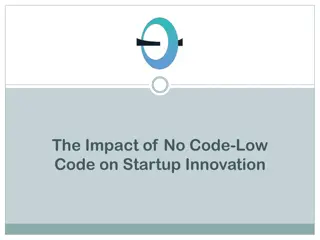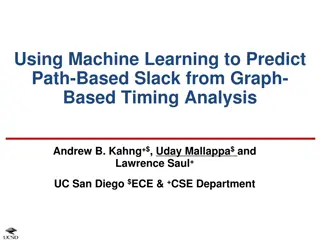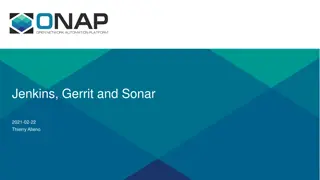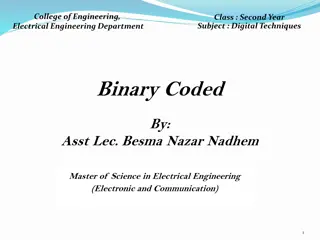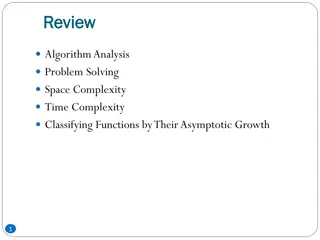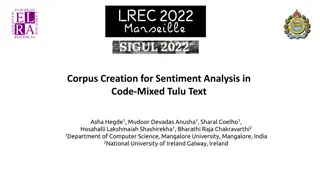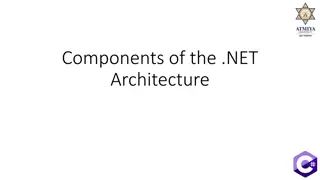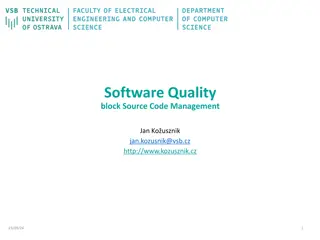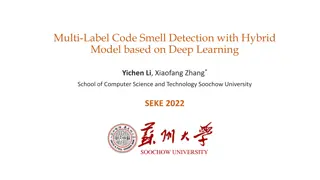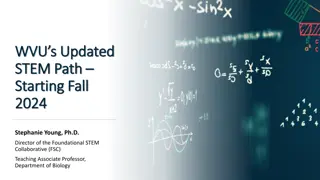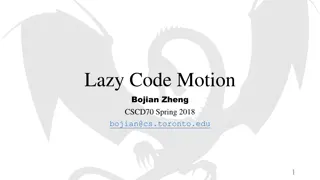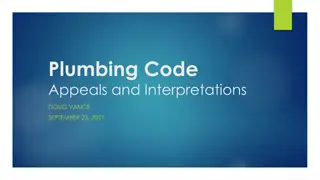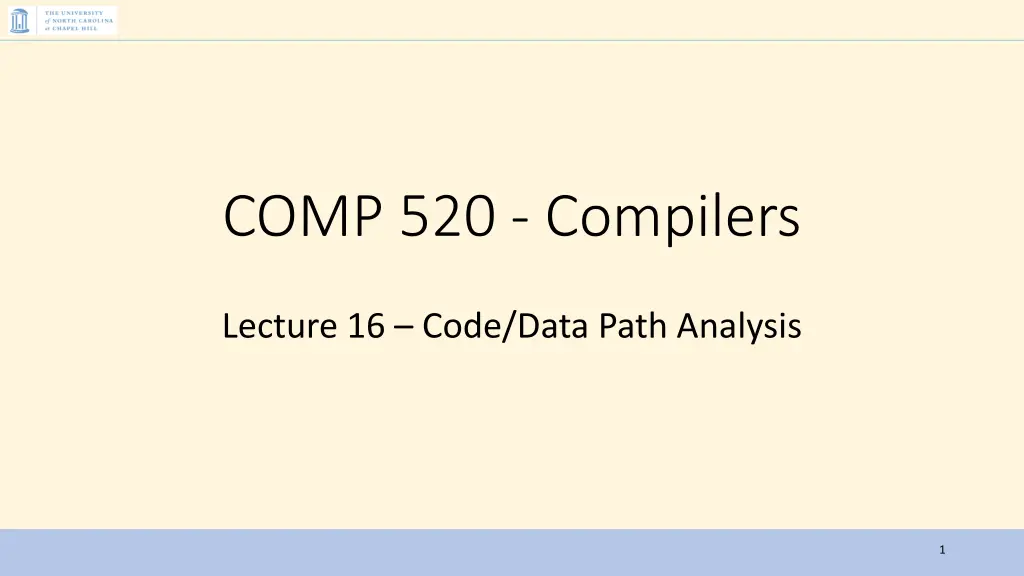
Compilers Lecture on Code and Data Path Analysis
Dive into the world of compilers with a focus on code and data path analysis. Explore topics like compiler optimization, dataflow analysis, and memory usage reduction strategies. Get insights on how compilers work their magic to optimize code and improve efficiency for developers. Stay informed about upcoming tests and assignments in this comprehensive lecture series.
Download Presentation

Please find below an Image/Link to download the presentation.
The content on the website is provided AS IS for your information and personal use only. It may not be sold, licensed, or shared on other websites without obtaining consent from the author. If you encounter any issues during the download, it is possible that the publisher has removed the file from their server.
You are allowed to download the files provided on this website for personal or commercial use, subject to the condition that they are used lawfully. All files are the property of their respective owners.
The content on the website is provided AS IS for your information and personal use only. It may not be sold, licensed, or shared on other websites without obtaining consent from the author.
E N D
Presentation Transcript
COMP 520 - Compilers Lecture 16 Code/Data Path Analysis 1
Reminders If you submitted PA3 late, make a private post on Piazza so we can determine an appropriate grade. Submit to Partial tests, and your first submission to Hidden tests implies you need a grade. Midterm 2 on next Thursday, 4/11 2 COMP 520: Compilers S. Ali
Reminders (2) As of Lec 15, you have everything you need to do PA4. Start sooner rather than later. Midterm 2 on next Thursday, 4/11 3 COMP 520: Compilers S. Ali
Compiler Compiler Optimization Optimization Code Analysis Dataflow Analysis Register Minimalization Multiple CodePath Generation Data Liveness Expr Liveness TODAY 4 COMP 520: Compilers S. Ali
Compilers are magic magic This phrase is humorous. For the compiler developer, not so much. What exactly is so magical about a compiler? It has the ability to nearly ignore how the programmer wrote code, and instead does something equivalent and more optimized. (not always a good thing) 5 COMP 520: Compilers S. Ali
Today Data and Expression Liveness analysis Algorithms to analyze data usage and memory dependencies Goal Reduce memory usage and instruction count. 6 COMP 520: Compilers S. Ali
Motivation Variable b and c are never used at the same time Can save space by not keeping both in memory 7 COMP 520: Compilers S. Ali
Motivation (2) We have two int variables, but after line 3, numBytes is never used again Ask the developer to change the code? 8 COMP 520: Compilers S. Ali
Motivation (3) Old But we now have a problem, the variable name numBytes does not actually describe its function To support good coding practices, we will need to solve how to reduce memory consumption without asking the developer to change their programming habits. New 9 COMP 520: Compilers S. Ali
Problem Statement Programmers create variables whenever. They do not want to reuse variables that are available. On limited compute capacity machines, we cannot afford to waste memory. 10 COMP 520: Compilers S. Ali
Scoped Data Liveness A suboptimal but simple solution. 11 COMP 520: Compilers S. Ali
Scoped Data Liveness Recall: when a local variable is declared, create stack space for it (simple PA4, Lec14-15) Idea: whenever a scope closes, reclaim stack space. 12 COMP 520: Compilers S. Ali
Scoped Data Liveness (2) Idea: whenever a scope closes, reclaim stack space. push 0 # Create Stack Space &x = rbp-8 Code Gen RIP 13 COMP 520: Compilers S. Ali
Scoped Data Liveness (3) Idea: whenever a scope closes, reclaim stack space. push 0 # Create Stack Space &x = rbp-8 push 0 # Create &y = rbp-16 Code Gen RIP 14 COMP 520: Compilers S. Ali
Scoped Data Liveness (4) Idea: whenever a scope closes, reclaim stack space. push 0 # Create Stack Space &x = rbp-8 push 0 # Create &y = rbp-16 mov rax, 2 imul [b] mov [y],rax add rsp,8 # Reclaim y s space RIP Code Gen 15 COMP 520: Compilers S. Ali
Scoped Data Liveness Not Optimal Why is this not enough? 16 COMP 520: Compilers S. Ali
Scoped Data Liveness Counterexample At this point, variable a is no longer used. Thus, some other strategy can be better. 17 COMP 520: Compilers S. Ali
When you have really long methods.. If the programmer writes bad code, then sure, we have no obligation to make sure it runs. But you can t dictate programming habits, and what if some methods just end up being very complicated? Also, we would want our compiler to work even if others don t. 18 COMP 520: Compilers S. Ali
Scoped Data Liveness Overview Overview: Reclaim stack space when a scope ends. Not optimal (too coarse-grain). In PA4: expected to clean up the stack to some degree, and scoped liveness fulfills that requirement. We now study better techniques. 19 COMP 520: Compilers S. Ali
Definition: Live Variable Let s formalize data liveness. A variable x is live before an instruction if x is assigned a value before that point, and an instruction will use x after that point. Defn. Liveness is overloaded. Liveness also refers to ensuring lock requests are eventually satisfied. Instead, we call it Data Liveness, which is a part of Dataflow Analysis. 20 COMP 520: Compilers S. Ali
Optimality Concerns Data Liveness Analysis may overly designate variables as live . Better than the opposite. Very difficult in some languages. Example: access variables by memory offsets. Output: 21 COMP 520: Compilers S. Ali
Control Flow Graphs (CFGs) A super unfortunate acronym. CFG in parsing is context-free grammar. CFG in code generation is a control flow graph. 22 COMP 520: Compilers S. Ali
Basic Control Flow Graph AssignStmt CallStmt WhileStmt AssignStmt ReturnStmt 23 COMP 520: Compilers S. Ali
Exploded Flow Graph AssignStmt Fall-Through Edges CallStmt WhileStmt AssignStmt ReturnStmt 24 COMP 520: Compilers S. Ali
CFG Edges Vertex Operation (Instruction/Concrete AST) In-Edge Directed edge going to the vertex Out-Edge Directed edge going out of the vertex Successor/Predecessor All vertices connected by an out/in-edge Defn. In-Edges Operation Def: in(?) Set of all variables live at In-Edges (before vertex ?) Def: out(?) Set of all variables live at Out-Edges (after vertex ?) Out-Edges 25 COMP 520: Compilers S. Ali
Define Data Liveness at Edges (before and after) Consider a motivating example: at Edges int x = y + 1 (Assume y never used again) So both x and y can use: [rbp-8] 26 COMP 520: Compilers S. Ali
Define Data Liveness at Edges (2) Live: { y } Construct CFG Consider a motivating example: tmp := y ?? Live: { tmp } int x = y + 1 (y never used again) So both x and y can use: [rbp-8] tmp:= tmp+1 ?? Note the addition of temp variables. This is a part of Dataflow Analysis. Live: { tmp } x := tmp ?? Live: { x } 27 COMP 520: Compilers S. Ali
Define Data Liveness at Edges (3) Live: { y } Generate Code Consider a motivating example: mov rax,[rbp-8] rax := y Live: { rax } int x = y + 1 (y never used again) So both x and y will use: [rbp-8] inc rax rax := rax + 1 Temporary variables will turn into registers eventually. Live: { rax } mov [rbp-8],rax x := rax Live: { x } 28 COMP 520: Compilers S. Ali
Can visually see it, but how can we detect such optimizations? We will need more tools! rax := y mov rax,[rbp-8] rax := rax + 1 x := y + 1 inc [rbp-8] inc rax x := rax mov [rbp-8],rax Don t worry about such optimizations until you are done with PA4 29 COMP 520: Compilers S. Ali
More Definitions Set: use(v) Set: def(v) use(v) The set of variables used by vertex v. def(v) The set of variables that are defined by vertex v. Somewhat of a misnomer, it is variables whose values are assigned by the vertex v. E.g. v z = z * 2 def(v) = { z } use(v) = { z } E.g. v z = x + y use(v) = { x, y } def(v) = { z } 30 COMP 520: Compilers S. Ali
? ? ? Constraints use(v) in(v) Why? out(v) \ def(v) in(v) Why? s : s successor(v) :: in(s) out(v) Why? 31 COMP 520: Compilers S. Ali
? ? ? Constraints (2) I0 use(v) in(v) If we use the variable, it was live before the vertex is entered. I1 out(v) \ def(v) in(v) If a variable that we didn t assign is live after v, then it was live when we enter v. I2 s : s successor(v) :: in(s) out(v) If a variable is live when entering a successor, then it must be live when exiting the vertex. 32 COMP 520: Compilers S. Ali
? ? ? Other Languages I0 use(v) in(v) If we use the variable, it was live before the vertex is entered. Not always possible to determine in other languages Compile-time error in Java (save for PA5) because x is uninitialized. 33 COMP 520: Compilers S. Ali
? ? ? Goal I0 use(v) in(v) I1 out(v) \ def(v) in(v) I2 s : s successor(v) :: in(s) out(v) Can actually use these constraints to our advantage! 34 COMP 520: Compilers S. Ali
Iterative Data Liveness Analysis 35 COMP 520: Compilers S. Ali
Initialization (Base Case) Start: ? = ?,? Initialize: ? ? ? in ? ? ? ? out ? ? ? ? Determine def(?), use(?) Note: constraints are probably not yet satisfied. 36 COMP 520: Compilers S. Ali
Iterative Step Evaluate: out ? ? successor(?)in(?) What is this doing? in ? use ? out ? \ def ? What is this doing? 37 COMP 520: Compilers S. Ali
Iterative Step (2) Evaluate in-order: out ? ? successor(?)in(?) If a successor needs a live variable, then it must be live when exiting ? in ? use ? out ? \ def ? What is this doing? 38 COMP 520: Compilers S. Ali
Iterative Step (3) out ? ? successor(?)in(?) in ? use ? out ? \ def ? What is this doing? 39 COMP 520: Compilers S. Ali
Iterative Step (4) out ? ? successor(?)in(?) in ? use ? out ? \ def ? If ? uses the variable, it must be live upon entry Union with: variables that must be live afterwards, except the variables that are set by ?. We don t need such assigned variables live, unless we use their previous value. 40 COMP 520: Compilers S. Ali
Fixed-Point Stop when: I3 All constraints met (I0 I1 I2) STOP I4 All sets in/out do not change STOP When done by I4, I3 is too, so only check in/out sets. Curious why? See COMP-735 (Spring 2025) Use well-founded closure rule, eventually, I4 I3 Analyzing data liveness algorithms not a part of this class 41 COMP 520: Compilers S. Ali
Example: if( x 0 ) y = w + 1 y = 0; x = 10; z = 2; w = 0; while( x > 0 ) { y = w + 1; x = x 1; z = 2 * z; w = z / y; } return y; x = x - 1 z = 2 * z w = z / y; return y 42 COMP 520: Compilers S. Ali
in: Initialization. if( x 0 ) use: x out: in: y = w + 1 Determine sets: use/def Assign all in/out to u: w def: y out: in: x = x - 1 use: x def: x out: in: z = 2 * z use: z def: z out: in: w = z / y; u: z, y d: w out: in: return y use: y 43 COMP 520: Compilers S. Ali
x Iteration 1 if( x 0 ) use: x w y = w + 1 for( ? ? ) { out ? ?: in(?) in ? use ? out ? \ def ? u: w def: y x x = x - 1 use: x def: x } z z = 2 * z use: z def: z If done in-order, then most of the first iteration is easy. Watch out for x, y, z w = z / y; u: z, y d: w x y return y use: y 44 COMP 520: Compilers S. Ali
w, x, y Iteration 2 if( x 0 ) use: x w, y w y = w + 1 for( ? ? ) { out ? ?: in(?) in ? use ? out ? \ def ? u: w def: y x x = x - 1 use: x def: x } z z = 2 * z use: z def: z x, y, z Watch out for checking all successors: w = z / y; u: z, y d: w x y return y use: y 45 COMP 520: Compilers S. Ali
w, x, y Iteration 2 (2) if( x 0 ) use: x w, y w, x y = w + 1 for( ? ? ) { out ? ?: in(?) in ? use ? out ? \ def ? u: w def: y x x x = x - 1 use: x def: x } z z = 2 * z use: z def: z x, y, z w = z / y; u: z, y d: w x y return y use: y 46 COMP 520: Compilers S. Ali
w, x, y Iteration 2 (3) if( x 0 ) use: x w, y w, x y = w + 1 for( ? ? ) { out ? ?: in(?) in ? use ? out ? \ def ? u: w def: y x x, z x = x - 1 use: x def: x z } z z = 2 * z use: z def: z x, y, z w = z / y; u: z, y d: w x y return y use: y 47 COMP 520: Compilers S. Ali
w, x, y Iteration 2 (4) if( x 0 ) use: x w, y w, x y = w + 1 for( ? ? ) { out ? ?: in(?) in ? use ? out ? \ def ? u: w def: y x x, z x = x - 1 use: x def: x z } x, y, z z = 2 * z use: z def: z x, y, z x, y, z w = z / y; u: z, y d: w x y return y use: y 48 COMP 520: Compilers S. Ali
w, x, y Iteration 2 (5) if( x 0 ) use: x w, y w, x y = w + 1 for( ? ? ) { out ? ?: in(?) in ? use ? out ? \ def ? u: w def: y x x, z x = x - 1 use: x def: x z } x, y, z z = 2 * z use: z def: z x, y, z Note: no change here x, y, z w = z / y; u: z, y d: w w, x, y y return y use: y 49 COMP 520: Compilers S. Ali
w, x, y Iteration 3 if( x 0 ) use: x w, x, y w, x, z y = w + 1 for( ? ? ) { out ? ?: in(?) in ? use ? out ? \ def ? u: w def: y x, z x, y, z x = x - 1 use: x def: x x, y, z } x, y, z z = 2 * z use: z def: z x, y, z x, y, z w = z / y; u: z, y d: w w, x, y y return y use: y 50 COMP 520: Compilers S. Ali

